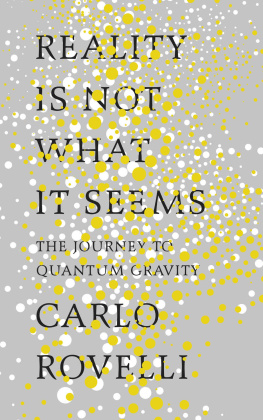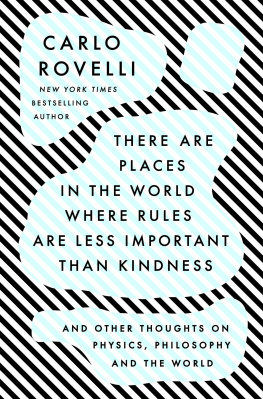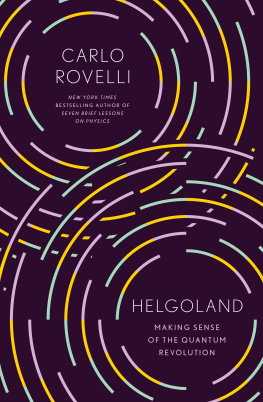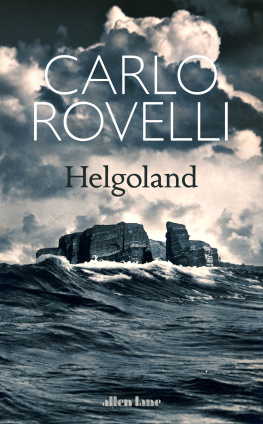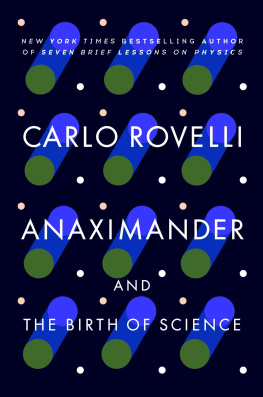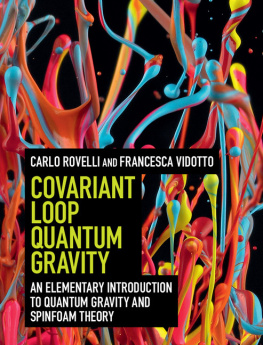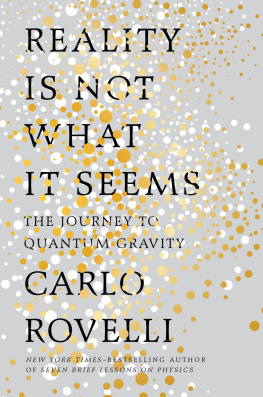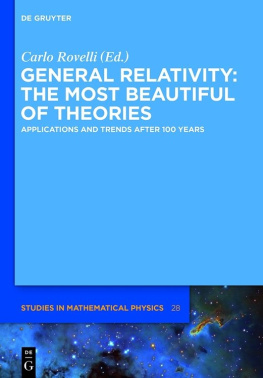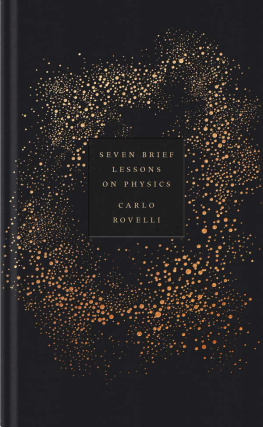Carlo Rovelli
REALITY IS NOT WHAT IT SEEMS
The Journey to Quantum Gravity
Translated by
Simon Carnell and Erica Segre
Contents
PART ONE
Roots
PART TWO
The Beginning of the Revolution
PART THREE
Quantum Space and Relational Time
PART FOUR
Beyond Space and Time
ABOUT THE AUTHOR
Carlo Rovelli is a theoretical physicist who has made significant contributions to the physics of space and time. He has worked in Italy and the US, and is currently directing the quantum gravity research group of the Centre de Physique Thorique in Marseille, France. His Seven Brief Lessons on Physics is a phenomenal international bestseller translated into forty-one languages.
Authors Note
During my entire research life, friends and curious people have asked me to explain what was going on in quantum gravity research. How was it possible to study new ways of thinking about space and time? Over and over again I have been asked to write a popular account of this research. While books on cosmology or string theory abound, a book describing the research on the quantum nature of space and time, and on loop quantum gravity in particular, did not yet exist. I have long hesitated, because I wanted to concentrate on research. Some years ago, after completing my technical book on the subject, I felt that the collective work of many scientists had moved the topic to a stage mature enough for a popular book. The landscape we are exploring is enchanting: why keep it hidden?
But I still delayed the project, because I could not see the book in my head. How to explain a world without space and time? One night in 2012, during a long solitary drive from Italy to France, I realized that the only way to explain in a comprehensible manner the ongoing modifications of the notions of space and time was to tell the story from the beginning: starting from Democritus, all the way through to the quanta of space. After all, this is how I understand the story. I began to design the entire book in my mind while driving, and got increasingly excited, until I heard a police cars sirens telling me to pull over: I was driving far above the speed limit. The Italian policemen asked me politely if I was crazy to drive at that speed. I explained that I had just found the idea Id been seeking for so long; the policeman let me go without a ticket, and wished me good luck with the book. This is the book.
This book was written and first published in Italian at the beginning of 2014. Shortly afterwards, I wrote a few articles on fundamental physics for an Italian newspaper. A prestigious Italian publisher, Adelphi, asked me for an extended version of these articles, to appear as a small booklet. This is the origin of the short book Seven Brief Lessons on Physics, which to my immense surprise has become an international bestseller and has opened a beautiful channel of communication between me and so many wonderful readers all over the world. The Seven Lessons were thus written after this book, and to some extent they are a synthesis of some of the topics you find here. If you have read Seven Brief Lessons on Physics and want to know more, to journey deeper into the strange world that book sketched, here you can find more.
While the account of established physics I give here is presented from the peculiar perspective in which I understand it, it is largely uncontroversial. However, the part of this book that describes current research in quantum gravity is my own personal understanding of the state of the art. This is the region at the boundary between what we have understood and what we do not yet understand, and is still far from achieving consensus. Some of my physicist colleagues will agree with what I write here; others wont. This is true for all presentations of ongoing research at the frontiers of knowledge, but I prefer to state it upfront and clearly. This is not a book about certainties: it is a book about the adventure of moving towards the unknown.
As a whole, this is a travel book describing one of the most spectacular journeys that humanity has taken: a journey out of our limited and parochial views of reality, towards an increasingly vast understanding of the structure of things. A magical journey out of our common-sense view of things, far from complete.
Marseille, 4 May 2016
Preface: Walking along the Shore
We are obsessed with ourselves. We study our history, our psychology, our philosophy, our gods. Much of our knowledge revolves around man himself, as if we were the most important thing in the universe. I think I like physics because it opens a window through which we can see further. It gives me the sense of fresh air entering the house.
What we see out there through the window is constantly surprising us. We have learned a great deal about the universe. In the course of the centuries we have come to realize just how very many wrong ideas we had. We thought that the Earth was flat, and that it was the still centre of our world. That the universe was small, and unchanging. We believed that man was a breed apart, without kinship to the other animals. We have learned of the existence of quarks, black holes, particles of light, waves of space, and of the extraordinary molecular structures in every cell of our bodies. The human race is like a growing child who discovers with amazement that the world consists not just of his bedroom and playground, but that it is vast, and that there are a thousand things to discover, and innumerable ideas quite different from those with which he began. The universe is multiform and boundless, and we continue to stumble upon new aspects of it. The more we learn about the world, the more we are amazed by its variety, beauty and simplicity.
But the more we discover, the more we understand that what we dont yet know is greater than what we know. The more powerful our telescopes, the stranger and more unexpected are the heavens we see. The closer we look at the minute detail of matter, the more we discover of its profound structure. Today we see almost to the Big Bang, the great explosion from which, 14 billion years ago, all the galaxies were born but we have already begun to glimpse something beyond the Big Bang. We have learned that space is curved, but already foresee that this same space is woven from vibrating quantum grains.
Our knowledge of the elementary grammar of the world continues to grow. If we try to put together what we have learned about the physical world in the course of the twentieth century, the clues point towards something profoundly different from what we were taught at school. An elementary structure of the world is emerging, generated by a swarm of quantum events, where time and space do not exist. Quantum fields draw space, time, matter and light, exchanging information between one event and another. Reality is a network of granular events; the dynamic which connects them is probabilistic; between one event and another, space, time, matter and energy melt in a cloud of probability.
This strange new world is slowly emerging today from the study of the main open question posed in fundamental physics: quantum gravity. Its the problem of coherently synthesizing what we have learned about the world with the two major discoveries of twentieth-century physics: general relativity and quantum theory. To quantum gravity

